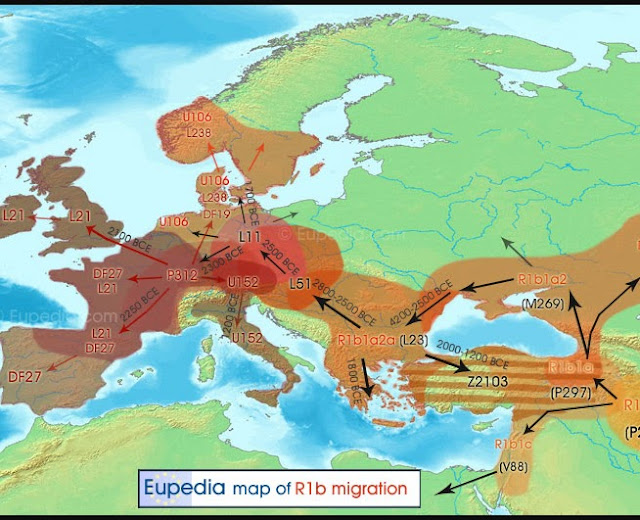My Ancient Origins, Part Two
 |
| Ancient migration of the R1b Y-chromosome haplogroup |
Readers who are interested in genealogical DNA testing as an aid in family research might find the following interesting. My paternal line, i.e., my Campbell line, is primarily from Northwestern Europe. More specifically, we are Gaels from the Highlands of Scotland. My “roots” as identified by DNA analysis are, however, far more ancient than our normal concept of race or national identity.
As described in an earlier post, my father’s line belongs to the R1b Y-chromosome haplogroup. R1b is the most frequently occurring paternal lineage in Western Europe, as well as some parts of Russia and Central Africa. The clade is also present at lower frequencies throughout Eastern Europe, Western Asia, as well as parts of North Africa and Central Asia. According to DNA studies, R1b expanded from the Caspian Sea along with the Indo-European languages. The age of R1 was estimated by Tatiana Karafet at between 12,500 and 25,700 BP, and most probably occurred about 18,500 years ago. And R1b must have arisen relatively soon after the emergence of R1.
Haplogroup R-M269 is the sub-clade of haplogroup R1b and is a short form for R1b1a1b. It is now the most common Y-DNA lineage in European males. It is carried by an estimated 110 million males in Europe. R-M269 has received significant interest because of its connection to the Indo-European expansion in Europe. R-M269 likely originated in Western Asia and was present in Europe by the Neolithic period. Its distribution within Europe is mainly due to human migrations of the Bronze and Iron Ages.
Further along my DNA lineage is sub-clade R1b-L21 (R1b1a2a1a2c), which is found mostly among the inhabitants of Ireland and Great Britain, but is also found in Brittany, northern France, modern Northern Portugal, Galicia and Asturias of the northwest Iberian peninsula, and has some presence in Belgium and the Netherlands. Readers are correct if they noticed that these are areas commonly associated with the Celtic people from which the Gaels of Scotland emerged. In future posts, we'll take a closer look at the Gaels.
Comments
Post a Comment